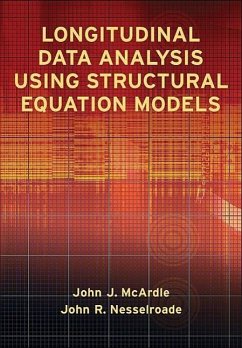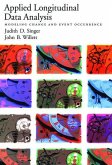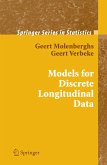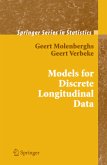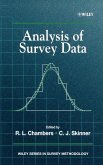- Gebundenes Buch
- Merkliste
- Auf die Merkliste
- Bewerten Bewerten
- Teilen
- Produkt teilen
- Produkterinnerung
- Produkterinnerung
The authors identify five basic purposes of longitudinal structural equation modeling. For each purpose, they present the most useful strategies and models. Two important but underused approaches are emphasized: multiple factorial invariance over time and latent change scores.
Andere Kunden interessierten sich auch für
![Applied Longitudinal Data Analysis Applied Longitudinal Data Analysis]() Judith D. SingerApplied Longitudinal Data Analysis160,99 €
Judith D. SingerApplied Longitudinal Data Analysis160,99 €![Discovering Statistics Using R Discovering Statistics Using R]() Andy FieldDiscovering Statistics Using R95,99 €
Andy FieldDiscovering Statistics Using R95,99 €![Linking and Aligning Scores and Scales Linking and Aligning Scores and Scales]() Neil J. Dorans / Mary Pommerich / Paul W. Holland (eds.)Linking and Aligning Scores and Scales76,99 €
Neil J. Dorans / Mary Pommerich / Paul W. Holland (eds.)Linking and Aligning Scores and Scales76,99 €![Advances in Comparative Survey Methods Advances in Comparative Survey Methods]() Advances in Comparative Survey Methods131,99 €
Advances in Comparative Survey Methods131,99 €![Models for Discrete Longitudinal Data Models for Discrete Longitudinal Data]() Geert MolenberghsModels for Discrete Longitudinal Data206,99 €
Geert MolenberghsModels for Discrete Longitudinal Data206,99 €![Models for Discrete Longitudinal Data Models for Discrete Longitudinal Data]() Geert MolenberghsModels for Discrete Longitudinal Data100,99 €
Geert MolenberghsModels for Discrete Longitudinal Data100,99 €![Analysis of Survey Data Analysis of Survey Data]() Analysis of Survey Data175,99 €
Analysis of Survey Data175,99 €-
-
-
The authors identify five basic purposes of longitudinal structural equation modeling. For each purpose, they present the most useful strategies and models. Two important but underused approaches are emphasized: multiple factorial invariance over time and latent change scores.
Produktdetails
- Produktdetails
- Verlag: American Psychological Association (APA)
- Seitenzahl: 426
- Erscheinungstermin: 16. Juni 2014
- Englisch
- Abmessung: 261mm x 182mm x 27mm
- Gewicht: 937g
- ISBN-13: 9781433817151
- ISBN-10: 1433817152
- Artikelnr.: 40454647
- Herstellerkennzeichnung
- Libri GmbH
- Europaallee 1
- 36244 Bad Hersfeld
- gpsr@libri.de
- Verlag: American Psychological Association (APA)
- Seitenzahl: 426
- Erscheinungstermin: 16. Juni 2014
- Englisch
- Abmessung: 261mm x 182mm x 27mm
- Gewicht: 937g
- ISBN-13: 9781433817151
- ISBN-10: 1433817152
- Artikelnr.: 40454647
- Herstellerkennzeichnung
- Libri GmbH
- Europaallee 1
- 36244 Bad Hersfeld
- gpsr@libri.de
John J. (Jack) McArdle, PhD, is senior professor of psychology at the University of Southern California (USC), where he heads the Quantitative Methods Area and has been chair of the USC Research Committee. He received a BA from Franklin amp amp Marshall College ( 973 Lancaster, PA) and both MA and PhD degrees from Hofstra University ( 975, 977 Hempstead, NY). He now teaches classes in psychometrics, multivariate analysis, longitudinal data analysis, exploratory data mining, and structural equation modeling at USC. His research was initially focused on traditional repeated measures analyses and moved toward age-sensitive methods for psychological and educational measurement and longitudinal data analysis, including publications in factor analysis, growth curve analysis, and dynamic modeling of abilities. Dr. McArdle is a fellow of the American Association for the Advancement of Science (AAAS). He served as president of the Society of Multivariate Experimental Psychology (SMEP, 992 amp ndash 993) and the Federation of Behavioral, Cognitive, and Social Sciences ( 99 amp ndash 999). A few other honors include the 987 R. B. Cattell Award for Distinguished Multivariate Research from SMEP. Dr. McArdle was recently awarded an National Institutes of Health-MERIT grant from the National Institute on Aging for his work, amp quot Longitudinal and Adaptive Testing of Adult Cognition amp quot (2 5 amp ndash 2 5), where he is working on new adaptive tests procedures to measure higher order cognition as a part of large-scale surveys (e.g. the Human Resources Services). Working with APA, he has created and led the Advanced Training Institute on Longitudinal Structural Equation Modeling (2 amp ndash 2 2), and he also teaches a newer one, Exploratory Data Mining (2 9 amp ndash 2 4). John R. Nesselroade, PhD, earned his BS degree in mathematics (Marietta College, Marietta, OH, 9 ) and MA and PhD degrees in psychology (University of Illinois at Urbana amp ndash Champaign, 9 5, 9 7). Prior to moving to the University of Virginia in 99 , Dr. Nesselroade spent 5 years at West Virginia University and 9 years at The Pennsylvania State University. He has been a frequent visiting scientist at the Max Planck Institute for Human Development, Berlin. He is a past-president of APA's Division 2 (Adult Development and Aging [ 982 amp ndash 983]) and of SMEP ( 999 amp ndash 2 ). Dr. Nesselroade is a fellow of the AAAS, the APA, the Association for Psychological Science, and the Gerontological Society of America. Other honors include the R. B. Cattell Award for Distinguished Multivariate Research and the S. B. Sells Award for Distinguished Lifetime Achievement from SMEP. Dr. Nesselroade has also won the Gerontological Society of America's Robert F. Kleemeier Award. In 2 , he received an Honorary Doctorate from Berlin's Humboldt University. He is currently working on the further integration of individual level analyses into mainstream behavioral research. The two authors have worked together in enjoyable collaborations for more than 25 years.
Preface
Overview
Part I: Foundations
Chapter : Background and Goals of Longitudinal Research
Chapter 2: Basics of Structural Equation Modeling
Chapter 3: Some Technical Details on Structural Equation Modeling
Chapter 4: Using the Simplified Reticular Action Model Notation
Chapter 5: Benefits and Problems Using Structural Equation Modeling in
Longitudinal Research
Part II: Longitudinal SEM for the Direct Identification of Intraindividual
Changes
Chapter : Alternative Definitions of Individual Changes
Chapter 7: Analyses Based on Latent Curve Models
Chapter 8: Analyses Based on Time-Series Regression Models
Chapter 9: Analyses Based on Latent Change Score Models
Chapter : Analyses Based on Advanced Latent Change Score Models
Part III: Longitudinal SEM for Interindividual Differences in
Intraindividual Changes
Chapter : Studying Interindividual Differences in Intraindividual Changes
Chapter 2: Repeated Measures Analysis of Variance as a Structural Model
Chapter 3: Multilevel Structural Equation Modeling Approaches to Group
Differences
Chapter 4: Multiple Group Structural Equation Modeling Approaches to Group
Differences
Chapter 5: Incomplete Data With Multiple Group Modeling of Changes
Part IV: Longitudinal SEM for the Interrelationships in Growth
Chapter : Considering Common Factors/Latent Variables in Structural Models
Chapter 7: Considering Factorial Invariance in Longitudinal Structural
Equation Modeling
Chapter 8: Alternative Common Factors With Multiple Longitudinal
Observations
Chapter 9: More Alternative Factorial Solutions for Longitudinal Data
Chapter 2 : Extensions to Longitudinal Categorical Factors
Part V: Longitudinal SEM for Causes (Determinants) of Intraindividual
Changes
Chapter 2 : Analyses Based on Cross-Lagged Regression and Changes
Chapter 22: Analyses Based on Cross-Lagged Regression in Changes of Factors
Chapter 23: Current Models for Multiple Longitudinal Outcome Scores
Chapter 24: The Bivariate Latent Change Score Model for Multiple Occasions
Chapter 25: Plotting Bivariate Latent Change Score Results
Part VI: Longitudinal SEM for Interindividual Differences in Causes
(Determinants) of Intraindividual Changes
Chapter 2 : Dynamic Processes Over Groups
Chapter 27: Dynamic Influences Over Groups
Chapter 28: Applying a Bivariate Change Model With Multiple Groups
Chapter 29: Notes on the Inclusion of Randomization in Longitudinal Studies
Chapter 3 : The Popular Repeated Measures Analysis of Variance
Part VII: Summary and Discussion
Chapter 3 : Contemporary Data Analyses Based on Planned Incompleteness
Chapter 32: Factor Invariance in Longitudinal Research
Chapter 33: Variance Components for Longitudinal Factor Models
Chapter 34: Models for Intensively Repeated Measures
Chapter 35: Coda: The Future Is Yours!
References
Index
About the Authors
Overview
Part I: Foundations
Chapter : Background and Goals of Longitudinal Research
Chapter 2: Basics of Structural Equation Modeling
Chapter 3: Some Technical Details on Structural Equation Modeling
Chapter 4: Using the Simplified Reticular Action Model Notation
Chapter 5: Benefits and Problems Using Structural Equation Modeling in
Longitudinal Research
Part II: Longitudinal SEM for the Direct Identification of Intraindividual
Changes
Chapter : Alternative Definitions of Individual Changes
Chapter 7: Analyses Based on Latent Curve Models
Chapter 8: Analyses Based on Time-Series Regression Models
Chapter 9: Analyses Based on Latent Change Score Models
Chapter : Analyses Based on Advanced Latent Change Score Models
Part III: Longitudinal SEM for Interindividual Differences in
Intraindividual Changes
Chapter : Studying Interindividual Differences in Intraindividual Changes
Chapter 2: Repeated Measures Analysis of Variance as a Structural Model
Chapter 3: Multilevel Structural Equation Modeling Approaches to Group
Differences
Chapter 4: Multiple Group Structural Equation Modeling Approaches to Group
Differences
Chapter 5: Incomplete Data With Multiple Group Modeling of Changes
Part IV: Longitudinal SEM for the Interrelationships in Growth
Chapter : Considering Common Factors/Latent Variables in Structural Models
Chapter 7: Considering Factorial Invariance in Longitudinal Structural
Equation Modeling
Chapter 8: Alternative Common Factors With Multiple Longitudinal
Observations
Chapter 9: More Alternative Factorial Solutions for Longitudinal Data
Chapter 2 : Extensions to Longitudinal Categorical Factors
Part V: Longitudinal SEM for Causes (Determinants) of Intraindividual
Changes
Chapter 2 : Analyses Based on Cross-Lagged Regression and Changes
Chapter 22: Analyses Based on Cross-Lagged Regression in Changes of Factors
Chapter 23: Current Models for Multiple Longitudinal Outcome Scores
Chapter 24: The Bivariate Latent Change Score Model for Multiple Occasions
Chapter 25: Plotting Bivariate Latent Change Score Results
Part VI: Longitudinal SEM for Interindividual Differences in Causes
(Determinants) of Intraindividual Changes
Chapter 2 : Dynamic Processes Over Groups
Chapter 27: Dynamic Influences Over Groups
Chapter 28: Applying a Bivariate Change Model With Multiple Groups
Chapter 29: Notes on the Inclusion of Randomization in Longitudinal Studies
Chapter 3 : The Popular Repeated Measures Analysis of Variance
Part VII: Summary and Discussion
Chapter 3 : Contemporary Data Analyses Based on Planned Incompleteness
Chapter 32: Factor Invariance in Longitudinal Research
Chapter 33: Variance Components for Longitudinal Factor Models
Chapter 34: Models for Intensively Repeated Measures
Chapter 35: Coda: The Future Is Yours!
References
Index
About the Authors
Preface
Overview
Part I: Foundations
Chapter : Background and Goals of Longitudinal Research
Chapter 2: Basics of Structural Equation Modeling
Chapter 3: Some Technical Details on Structural Equation Modeling
Chapter 4: Using the Simplified Reticular Action Model Notation
Chapter 5: Benefits and Problems Using Structural Equation Modeling in
Longitudinal Research
Part II: Longitudinal SEM for the Direct Identification of Intraindividual
Changes
Chapter : Alternative Definitions of Individual Changes
Chapter 7: Analyses Based on Latent Curve Models
Chapter 8: Analyses Based on Time-Series Regression Models
Chapter 9: Analyses Based on Latent Change Score Models
Chapter : Analyses Based on Advanced Latent Change Score Models
Part III: Longitudinal SEM for Interindividual Differences in
Intraindividual Changes
Chapter : Studying Interindividual Differences in Intraindividual Changes
Chapter 2: Repeated Measures Analysis of Variance as a Structural Model
Chapter 3: Multilevel Structural Equation Modeling Approaches to Group
Differences
Chapter 4: Multiple Group Structural Equation Modeling Approaches to Group
Differences
Chapter 5: Incomplete Data With Multiple Group Modeling of Changes
Part IV: Longitudinal SEM for the Interrelationships in Growth
Chapter : Considering Common Factors/Latent Variables in Structural Models
Chapter 7: Considering Factorial Invariance in Longitudinal Structural
Equation Modeling
Chapter 8: Alternative Common Factors With Multiple Longitudinal
Observations
Chapter 9: More Alternative Factorial Solutions for Longitudinal Data
Chapter 2 : Extensions to Longitudinal Categorical Factors
Part V: Longitudinal SEM for Causes (Determinants) of Intraindividual
Changes
Chapter 2 : Analyses Based on Cross-Lagged Regression and Changes
Chapter 22: Analyses Based on Cross-Lagged Regression in Changes of Factors
Chapter 23: Current Models for Multiple Longitudinal Outcome Scores
Chapter 24: The Bivariate Latent Change Score Model for Multiple Occasions
Chapter 25: Plotting Bivariate Latent Change Score Results
Part VI: Longitudinal SEM for Interindividual Differences in Causes
(Determinants) of Intraindividual Changes
Chapter 2 : Dynamic Processes Over Groups
Chapter 27: Dynamic Influences Over Groups
Chapter 28: Applying a Bivariate Change Model With Multiple Groups
Chapter 29: Notes on the Inclusion of Randomization in Longitudinal Studies
Chapter 3 : The Popular Repeated Measures Analysis of Variance
Part VII: Summary and Discussion
Chapter 3 : Contemporary Data Analyses Based on Planned Incompleteness
Chapter 32: Factor Invariance in Longitudinal Research
Chapter 33: Variance Components for Longitudinal Factor Models
Chapter 34: Models for Intensively Repeated Measures
Chapter 35: Coda: The Future Is Yours!
References
Index
About the Authors
Overview
Part I: Foundations
Chapter : Background and Goals of Longitudinal Research
Chapter 2: Basics of Structural Equation Modeling
Chapter 3: Some Technical Details on Structural Equation Modeling
Chapter 4: Using the Simplified Reticular Action Model Notation
Chapter 5: Benefits and Problems Using Structural Equation Modeling in
Longitudinal Research
Part II: Longitudinal SEM for the Direct Identification of Intraindividual
Changes
Chapter : Alternative Definitions of Individual Changes
Chapter 7: Analyses Based on Latent Curve Models
Chapter 8: Analyses Based on Time-Series Regression Models
Chapter 9: Analyses Based on Latent Change Score Models
Chapter : Analyses Based on Advanced Latent Change Score Models
Part III: Longitudinal SEM for Interindividual Differences in
Intraindividual Changes
Chapter : Studying Interindividual Differences in Intraindividual Changes
Chapter 2: Repeated Measures Analysis of Variance as a Structural Model
Chapter 3: Multilevel Structural Equation Modeling Approaches to Group
Differences
Chapter 4: Multiple Group Structural Equation Modeling Approaches to Group
Differences
Chapter 5: Incomplete Data With Multiple Group Modeling of Changes
Part IV: Longitudinal SEM for the Interrelationships in Growth
Chapter : Considering Common Factors/Latent Variables in Structural Models
Chapter 7: Considering Factorial Invariance in Longitudinal Structural
Equation Modeling
Chapter 8: Alternative Common Factors With Multiple Longitudinal
Observations
Chapter 9: More Alternative Factorial Solutions for Longitudinal Data
Chapter 2 : Extensions to Longitudinal Categorical Factors
Part V: Longitudinal SEM for Causes (Determinants) of Intraindividual
Changes
Chapter 2 : Analyses Based on Cross-Lagged Regression and Changes
Chapter 22: Analyses Based on Cross-Lagged Regression in Changes of Factors
Chapter 23: Current Models for Multiple Longitudinal Outcome Scores
Chapter 24: The Bivariate Latent Change Score Model for Multiple Occasions
Chapter 25: Plotting Bivariate Latent Change Score Results
Part VI: Longitudinal SEM for Interindividual Differences in Causes
(Determinants) of Intraindividual Changes
Chapter 2 : Dynamic Processes Over Groups
Chapter 27: Dynamic Influences Over Groups
Chapter 28: Applying a Bivariate Change Model With Multiple Groups
Chapter 29: Notes on the Inclusion of Randomization in Longitudinal Studies
Chapter 3 : The Popular Repeated Measures Analysis of Variance
Part VII: Summary and Discussion
Chapter 3 : Contemporary Data Analyses Based on Planned Incompleteness
Chapter 32: Factor Invariance in Longitudinal Research
Chapter 33: Variance Components for Longitudinal Factor Models
Chapter 34: Models for Intensively Repeated Measures
Chapter 35: Coda: The Future Is Yours!
References
Index
About the Authors

